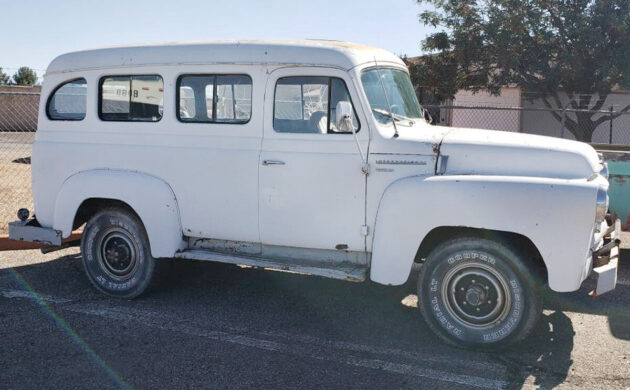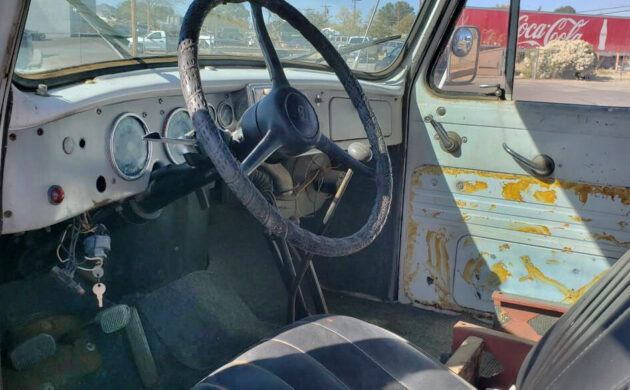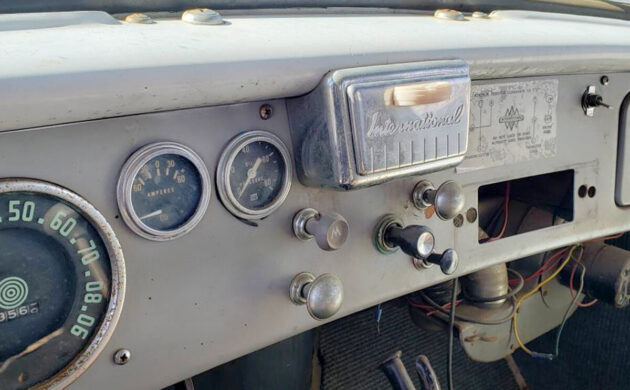The First SUV? 1956 International Travelall
There’s a lot of speculation and discussion as to what the first SUV was, at least in the United States. Considered by many as the first “SUV”, this 1956 International Travelall is posted here on craigslist in Sierra Vista, Arizona, and the seller is asking an eye-watering $11,999. Here is the original listing, and thanks to T.J. for sending in this tip!
The term SUV wasn’t even really widely accepted as a vehicle type until the 1980s, and even that can cause fist fights and general barroom shoving matches. We have gone over this question in the past here around the ol’ water cooler at One Barns Finds Tower and I’m not sure if there’s a consensus. It’s not exactly like the moon landing when there’s no question about who was the first to slice a golf ball into a crater. The first SUV? That’s a tougher one.
Many argue that due to its appearance in the mid-1930s, the Chevy and/or GMC Suburban would naturally be the first SUV. I could agree with that, even though, technically, the term SUV wasn’t around then and it was more of a truck-based vehicle. But, isn’t a Sequoia based on a Tundra, that’s a truck? A Suburban is based on a Chevy pickup, that’s a truck. How about the Willys Jeep Wagon from the mid-1940s? It’s certainly related to the 1984 Jeep Cherokee, widely regarded as the first SUV, at least by official designation under the government’s new category: the Sports/Utility Vehicle.
Whatever you all come up with in the comments section, this ’56 Travelall appears to be in fairly solid condition. International-Harvestor made the Travelall from 1953 through 1975 when the company got out of the business of personal vehicles, other than the Scout II, which would last until 1980. You noticed correctly in the first two photos, this Travelall has just two side doors. A third door on the passenger side would arrive for the 1958 model year. You also most likely saw the unique clamshell back doors. I wish the seller showed a photo of it with open back doors. The interior is a blank slate, as is the exterior, now that I think about it.
There is no 18-inch touchscreen here that takes nine screen changes to find the control to keep your skinny caramel pumpkin spice latte warm in the cup holder as a new SUV might have. Nope, this dash is American-made steel, the stuff that this country was built out of at one time (SG standing on a hill, flags waving in the background). Do not hit your forehead on that dash if you can help it.
The engine is hiding under a cool peek-a-boo side-opening hood and it should be a 220-cu.in. inline-six, even though the seller lists it as an eight-cylinder. But, if you zoom in on the air cleaner tag it sure looks like “240” to me, which would have been available beginning in late 1957 for the 1958 model year. In any case, this one isn’t running. I hope Howard and Geo and other truck experts are out there to identify this engine. We look forward to hearing all of your thoughts on this Travelall, and also, your thoughts on what the first SUV was.
Auctions Ending Soon
 2002 Subaru Impreza WRXBid Now11 hours$333
2002 Subaru Impreza WRXBid Now11 hours$333
 1975 Chevrolet Corvette ConvertibleBid Now12 hours$4,000
1975 Chevrolet Corvette ConvertibleBid Now12 hours$4,000
 1964 Ford F-100 Camper CustomBid Now13 hours$2,000
1964 Ford F-100 Camper CustomBid Now13 hours$2,000
 2006 Jeep Wrangler SportBid Now2 days$11,000
2006 Jeep Wrangler SportBid Now2 days$11,000
 1974 Datsun 260ZBid Now4 days$750
1974 Datsun 260ZBid Now4 days$750







Comments
The S series was the one year design, and this looks like a 3/4 ton and the 4×4 is incredibly rare. I believe by 1956, it’s a 240 and if we take the moniker “SUV” apart, what’s in there? “S”ports “U”tility “V”ehicle. Ask 10 people, you’ll get 10 different responses, like the 1st musclecar. Most will agree, it was the 1974 Jeep Cherokee SJ that 1st used the term in an ad, however, some say the 1963 Jeep wagon was the 1st. Regardless, in 1956, that term didn’t exist, and 4×4 wagons like this were a tough sell. People hadn’t begun to settle in outlandish, God forsaken regions, that REQUIRE a 4×4 on a sunny day, and most folks lived in city situations, where if it was too rough out, you simply stayed home. I think the “S” in SUV is the key word there, and sporty 4x4s, not mundane IH wagons, were the hot ticket. A nod to the Asians for that, and we never looked back. The “Utility” part, in most cases, was a low gear in 4 wheel drive, most never being used, but what if, is the sales gimmick there.
Great find, if you can handle that speedo. It always looked like a pinwheel spinning to me, depending on state of mind, of course.
Sure looks solid. Good luck!
cheers
GPC
Not an SUV. “SUV” denotes a RECREATIONAL purpose – SPORT Utility Vehicle.
This rig is all business. Like their tractors, this was to move, manipulate, distribute material and equipment.
The first? Arguably it was the Willys/Jeep Station Wagon, the so-called Basket-Weave model. That was sold to farmers and industries, but also to private owners, looking for hunting or fishing-related transport.
The Chevrolet Suburban, also, was intended for industrial buyers. This, true, even after the Jeep Wagoneer appeared. The Suburban of those years had two-doors only, and sliding passenger windows. Obviously a panel truck body with windows.
1974Jeep Cherokee was the first vehicle to advertise itself as an SUV, for whatever that is worth. This debate reminds me of: what was the first American sports car? Crosley claims the crown and so does Kurtis.
Crosley? Kurtis? Ok, but jumpback serveral decades to the Mercer Raceabout, Stutz Bearcat, Jordan Playboy, etc., etc., etc.!
1st sports car? Crosley? Kurtis? Ok, but jump back several decades to the Mercer Raceabout, Stutz Bearcat, Jordan Playboy, etc., etc., etc.!
[Sorry ’bout the typos above…]
the Chevy Suburban has been around since the thirties so it is probably the first SUV
Anyone for ’35 on the Suburban? All
Chevy did was put a panel body on
their FB chassis, add windows and some extra seats, and presto! instant
Carryall! That’s what they called them
years ago and we old timers call them today. No doubt in my mind that GM was the first to offer them to
the public. Everyone else followed
suit– with some firms more successful than others in that small
niche market back then. Just my .02
on the subject. Gotta go lay out and
draw a ’55 Pontiac Star Chief for a
customer. Great find though.
Restomod this puppy. Chop the roof about 4 inches, pull the body off and paint it a candy apple red, assess the frame & suspension, if restoration of that is too expensive, get your hands on a complete Ford Expedition frame, engine, transmission & rear end. $20-25k and you’re off & running.
Leave it original, and preserve a part of our automotive heritage. Destroying an original jewel like this should be a crime.
Restomod??? Blasphemy I say! This ol’ gal deserves to be put back into shape for doing what she was built to do, haul people, equipment, tools and materials to and from wherever they were needed. She was a workhorse and could be again! With style!
There were a lot of changes in the International line from ’56 to ’58. 1956 and 57 were actually designated for the S-series but that got disrupted by the Golden Jubilee in ’57 because ’57 was the 50th anniversary for International getting into the powered transportation market. But, starting in 1956 the S-series was introduced. It first came down the assembly line with a 6-Volt electrical system but there was a running change to 12V during that production year. The first S-series light trucks ran a B-engine which was essentially an SD just painted black. Somewhere through the confusion the B-engine received a new head with the valves angled for better air flow. That “Tilt Valve” engine became the “BD” series which would run 220, 240 and 264 into the 60s. The 220 faded away by 1960 (although I’ve heard of some stragglers into 1962). You can tell the difference between the two engines by looking at the width of the valve cover; the BD is wider. The engine can be identified by looking at the RH front side of the block, just under the head. There is a machined pad upon which is stamped the engine model number and the S/N# directly underneath.
While we’re on engines, a little tidbit on the offerings from ’61 to ’68. You’ll see BD220, BD240 and BD264. Then you’ll see BG241 and BG265. The latter two were 60s versions and you’ll see them in US built trucks. The BD engines were designated for the CDN and overseas markets. Don’t get too bent out of shape because the only difference is the BG engines were painted good ol’ #50 Harvester Red and the BD engines were black. Now the “Black Diamond” moniker is actually meant for the 282 and 308 (formerly the Blue Diamond) which were in the 170/180 series trucks and are not at all similar to the smaller engines except for the distributor cap, rotor and points. But people still call the smaller engine a Black Diamond and that’s OK.
Binder churned out a lot of Travelalls between ’53 and when it finally ended the light truck production. The body would’ve been essentially the same with the exception of late ’54 and up when the side window openings in the doors were deeper. In the regular cab trucks you would’ve also seen the change from the double rear windows to the single unit. It seems to me that the term, “Travelall,” was actually used in the days that Binder built and sold Woodies, but, according to my information, wasn’t official until later.
Now for this beast. International offered a 4×4 in the 1 1/2 ton trucks from ’53 to ’60. It was the “140” series. 1956 was the first time it was offered in a lighter truck, the 3/4 ton 120 series. There were quite a number of them sold although a Travelall version has got to be fairly scarce. If this one came my way, it would get the restoration treatment, right down to the idiot lights (on S-series and A-series). If it happened to have a BD220 engine I might be tempted to drop in something more substantial, like at least a 240. I heard that some 4×4 trucks of this vintage still used the Warner T-9 crashbox, which I would also be tempted to swap out for a T-98. Nice project for someone. And they look pretty good fixed up. The pic is a ’55 3/4 ton 2WD. I saw what the owner started out with and this is a real gem…
I love this International. I love the grille on this vehicle. The only upgrades I’d give it would be a Cummins 4BTA 4 cyl. engine, and automatic gearbox.
The 4BT/BT(A) is a highly adaptable engine for one of these. There’s a lot of people who would like to drop a 6 cylinder in there but it’s a tad too long. I have one customer who did an S-series with a GM 6.5 and he did a great job.
$11K and it doesn’t run? Straight out Junk & Scrap dealers Retail price guide. Another individual who mistakes Old as meaning$$$$$$$$$$. Serve him right if no one offers to buy it.
Prices like this ruin the market for reasonably price vehicles by asking outrageous prices for vehicles that are 1 grade above scrap.
For early people movers, don’t forget the Dodge Carryall. 39 to early 42 it was a civilian vehicle. It went back to that after the war.
Awesome looking International Travelall. Assuming parts are available, this would make an awesome resto project. I can imagine camping in this. I’d install a Cummins 3.9 litre 4 cyl. Turbo Diesel engine under the hood. :)
@ geomechs: Another diesel conversion to consider for a vehicle like this. Either a 6.5 GM Turbo Diesel V8 engine, or a Cummins 3.9 litre 4 cyl Turbo Diesel engine. Which ever fits comfortable.
Michael Myers drove a1956 International Harvester Travelall S Series in 1998’s Halloween H20.
He ripped it off at a car lot, shoot this one may be the one and the same !!